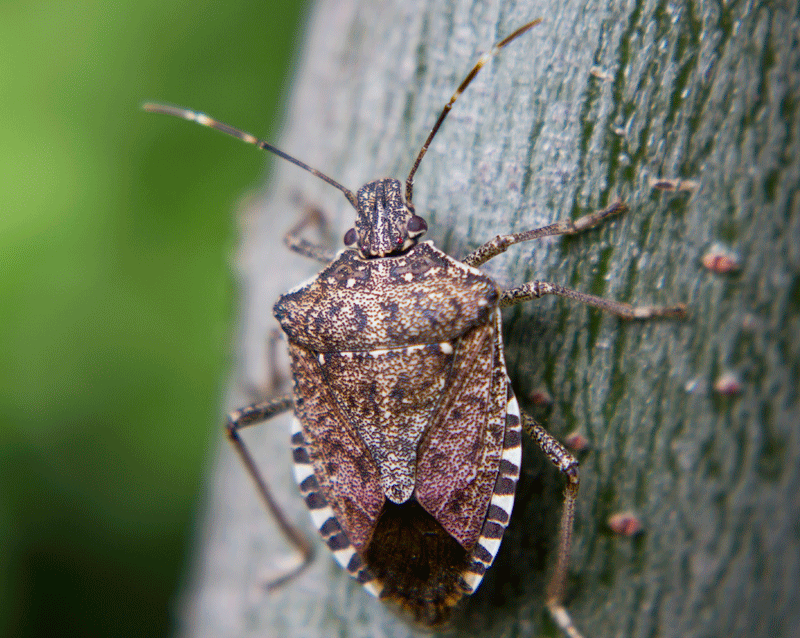BMSB reaches Ontario
CORN AND SOYBEAN CROPS AT RISK
FARMERS HAVE TO deal with many harmful insects and diseases to maximize yield and maintain the quality of their crop. They must constantly be on alert to identify and treat these issues as soon as they come up to prevent damage, or to prevent spreading to other crops, fields, or geographical areas. The latest threat is from the brown marmorated stink bug (BMSB).

BMSB is an invasive species from Asia. It made its way to North America in the late 1990s and has continued its spread through 42 states and into Ontario and Quebec. This well-travelled insect moves easily with the help of cargo and vehicles, but is also capable of natural spread. Efforts to monitor populations in Ontario have found the BMSB in the Niagara Escarpment and in the Hamilton area. Overwintering populations now exist in many locations across Ontario, with established populations also in London, Windsor, St. Catharines, and Newboro.
In addition to its wide geographical range, the BMSB also has a very wide host range of over 170 species. BMSB can live on tree fruit, berries, grapes, vegetables, corn, soybeans, tomatoes, okra, ornamental trees and shrubs, and more. BMSB, like other stink bugs, damage crops with their mouthparts.
CROP DAMAGE
BMSB can injure corn kernels and soybean seeds, resulting in absent or deformed and shrivelled, unmarketable grain. According to Tracey Baute, field crop entomologist program lead with the Ontario Ministry of Agriculture, Food and Rural Affairs (OMAFRA), “work done in Virginia on soybeans found one bug per foot of row can lead to up to a 40 bushel per acre loss, so thresholds for the pest will need to be lower than that.”
“Injury to the soybean plant by BMSB results in aborted or undeveloped pod, and punctured and deformed seed. Both result in reductions in seed quality and yield. Stay green syndrome, or a delay in maturity in soybeans, is also an issue,” adds Baute.
Baute also says Ontario corn could be at risk. “A bigger concern for Ontario corn will be the potential for mycotoxin development due to the wounds the stink bugs will create in the corn ears. This will need to be investigated here once we have some populations to work with.”
POPULATION GROWTH
BMSB is still a relatively new pest to Ontario, so populations are still quite low in most areas. According to Hannah Fraser, entomology program lead with OMAFRA Horticulture, it is difficult to predict how populations will change over time.
“So far, we only have stink bug injury on two apple farms where BMSB has been detected near Hamilton, and damage was at very low levels. It’s just too early to tell what impact BMSB will have in Ontario,” says Fraser.
OMAFRA monitored 62 corn fields, 60 soybean fields, and five edible bean fields among the 250 total sites used for a research study over the past two years. Fraser says, “we have trapped BMSB at some of the survey locations (tree fruit sites); most of these have been adults in pheromone traps. We have also found established populations at various locations in the Hamilton area (2012-2014), London (2014), Windsor (2014), St. Catharines (2014), and Newboro (2013- 2014), as well as in homes in Brampton.”
BMSB does not cause damage to homes but seeks refuge in structures to survive the winter.
DETECTION
First detection in the field is crucial for the preparedness of growers for BMSB. According to Fraser, experiences in the United States have shown that BMSB can go from difficult to detect to causing economic injury quickly.
To help with first detection, farmers should know what BMSB looks like and make sure to search for it while scouting for other pests. BMSB can be identified by examining the antennae of the insect; BMSB have two white bands on each antenna. Later instar nymphs have a white band on each of their legs. BMSB also have rounded shoulder tips and no serration on their shoulders.
BMSB will often use buckthorn and honeysuckle as hosts, which are most often found along the border areas of fields; in addition to monitoring crops, farmers should check these wild hosts to help with early detection. Fraser says commercial pyramid traps and blacklight traps could be useful for early detection in some crops. Depending on the crop, BMSB may be present from late May until harvest.
Management options exist for BMSB. There are some insecticides registered for managing the pest, but other solutions are currently under development. According to Fraser, these solutions will most likely include a combination of management strategies including insecticides, biological controls, trap crops, and other novel approaches.
Since BMSB began to be a formidable pest in the United States in 2009, enormous strides have been made in understanding the biology of the BMSB and how to monitor, manage, and prevent damage to crops in Canada through research done in the United States. Great efforts have also been made in educating both the farming and non-farming community in identifying and managing BMSB, which will continue to help prevent the insect from becoming a larger, more damaging problem in Ontario. •

















